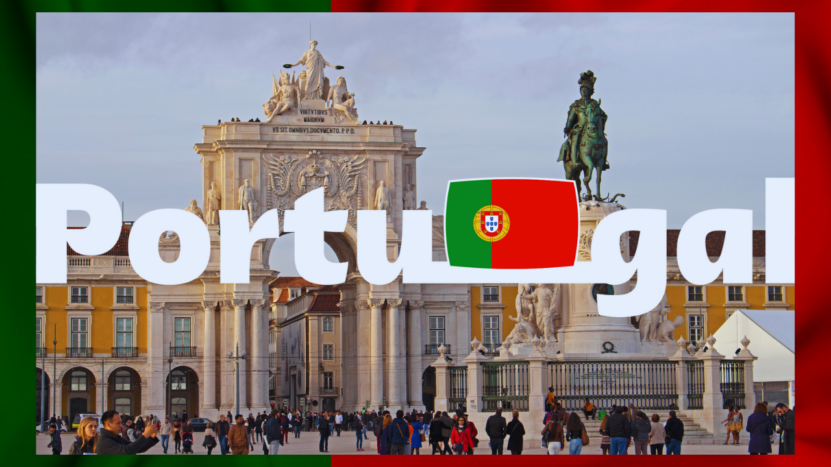Portugal is a country that seamlessly blends rich history, vibrant culture, and stunning natural beauty, making it one of the most sought-after travel destinations in Europe.
With its medieval castles, world-class wine regions, picturesque landscapes, and warm, welcoming people, there’s no shortage of places to explore.
We’ll discuss the best cities and towns in Portugal that you should visit in 2024.
10. Cascais
Cascais is a charming coastal town just a short drive from Lisbon. It’s known for its pleasant weather, making it a great spot for relaxing by the sea. You can enjoy the golden sands and clear waters at beaches like Guincho Beach.
Stroll through the Centro Histórico, the historic center of Cascais. Narrow streets are lined with shops, cafes, and landmarks. Don’t miss the opportunity to visit the striking Cascais Marina.
Another highlight is the COOLJAZZ festival in July, which attracts jazz lovers from around the globe. In August, the Festas do Mar transforms Cascais Bay into a ten-day musical celebration.
Outdoor activities are abundant here. With several parks and trails, including the scenic views of the Boca do Inferno, outdoor lovers will find plenty to explore.
Cascais also offers cultural experiences. Visit the Museu Condes de Castro Guimarães, housed in a historic mansion, or the Paula Rego House of Stories, which celebrates the works of the famous Portuguese artist.
9. Tavira
Tavira is a charming town in the eastern Algarve region of Portugal. Known for its rich history and scenic settings, it offers an array of attractions that are both cultural and natural.
Stroll through the cobbled streets of Tavira’s Old Town. Here, you’ll find the Roman bridge and ancient churches, each with its own story to tell. The Porta de Dom Manuel, a gateway from 1520, is a must-see.
Visit the Tavira Castle, which provides incredible views of the surrounding area. The castle grounds also feature beautiful gardens that are perfect for a peaceful walk.
Anchor Cemetery at Barril Beach is another interesting spot. The beach itself is serene, providing a great place to relax and enjoy the sun.
Don’t miss out on the village of Cabanas and its stunning beach. The nearby fishing port of Olhão is ideal for a day trip and offers a glimpse into traditional Portuguese life.
For nature lovers, the Parque Natural da Ria Formosa is a haven of diverse wildlife and scenic landscapes. You can explore the park by boat or along the walking trails.
The island of Tavira boasts some of the best beaches in the region. Clear waters and soft sand make it a perfect place for swimming and sunbathing.
Pego do Inferno, a small waterfall and lake, is located in the parish of Santo Estêvão. Visiting this hidden gem is a refreshing experience.
8. Funchal
Funchal, the capital of Madeira, is a vibrant and historic city. It’s known for its colorful downtown with charming streets and a lively atmosphere.
The city is famous for its lush botanical gardens. These gardens showcase a variety of exotic plants and offer stunning views of the island.
Funchal’s market, Mercado dos Lavradores, is a must-see. You can find fresh produce, flowers, and local crafts here, giving you a taste of the island’s culture.
Explore the old town, Zona Velha, where you’ll find narrow streets filled with art and door paintings. It’s a great place to wander and discover local cafes and restaurants.
Make sure to visit Pico do Arieiro, one of Madeira’s highest peaks. The panoramic views are breathtaking, especially at sunrise or sunset.
For a unique experience, take the cable car up to Monte and enjoy the picturesque landscape. You can also visit the Monte Palace Tropical Garden here.
Funchal is also home to some fascinating museums like the Madeira Story Centre, which tells the history of the island.
7. Évora
Évora, the capital of the Alentejo region, is a UNESCO World Heritage Site with a rich history. As you wander through this historic city, you’ll encounter Roman ruins, Gothic churches, and medieval architecture.
One of the main attractions is the Roman Temple of Évora, also known as the Temple of Diana. This ancient site offers a glimpse into the city’s Roman past.
The Gothic Cathedral of Évora is another must-see. Its impressive structure and beautiful interior captivate visitors from all over.
Don’t miss the Chapel of Bones, a unique and somewhat eerie site. The chapel is decorated with human bones, symbolizing the transience of life.
The city also boasts a vibrant university atmosphere, adding a youthful energy to its historic charm. You can explore narrow streets filled with cafes, shops, and local eateries.
The surrounding Alentejo region is famous for its olive groves, vineyards, and charming villages. A short drive outside Évora will lead you to picturesque landscapes and ancient megalithic sites.
Évora’s cuisine and wines are a treat for food lovers. Traditional dishes and locally produced wines give you a taste of the region’s rich culinary heritage.
6. Aveiro
Aveiro is known as the “Venice of Portugal” due to its picturesque canals. You can take a ride on a moliceiro boat, which is similar to a gondola. This gives you a unique perspective of the city.
The city has a rich history with salt production. Visit the Troncalhada Marine Ecomuseum to learn about this important industry.
Aveiro also offers stunning architecture. The Museum of Aveiro, housed in a former convent, displays beautiful azulejos (tiles).
Outdoor activities are plentiful. You can cycle along the Aveiro Lagoon or have a relaxing picnic at Dom Pedro Infante Park.
For a taste of local cuisine, try the famous Portuguese sweets like Ovos Moles. These delicious treats are unique to the region.
The maritime history of Aveiro and nearby Ílhavo adds a fascinating layer to your visit. Both towns have been important fishing centers since Roman times.
Train connections make it easy to reach Aveiro. From Porto or Coimbra, you can expect frequent and affordable trips.
Aveiro provides a blend of cultural experiences and natural beauty.
5. Coimbra
Coimbra, located in central Portugal, is a city rich in history and education. Known for its prestigious university, which dates back to 1290, Coimbra is often a highlight for travelers.
When you stroll through Coimbra, you’ll notice its charming cobblestone streets.
These pathways lead you to various historical landmarks, including the Old Cathedral (Se Velha). This Romanesque masterpiece is a must-see and offers insight into the city’s religious history.
You should also visit Conímbriga, Portugal’s largest ancient Roman settlement. It offers a glimpse into the country’s ancient past. For nature lovers, the Botanic Garden is a lovely retreat featuring exotic plants.
Coimbra is well-connected by public transport, making it an easy city to explore. Fast trains to and from Lisbon and Porto make this city accessible for a day trip or a multi-day stay.
The student population adds vibrant energy to the city’s blend of ancient and modern life.
4. Braga
Braga is a must-visit city in northern Portugal. Known for its rich history and culture, it offers a unique blend of old and new.
Start with the Sé de Braga, the city’s ancient Gothic cathedral. It has played a significant role in Portugal’s history. You can explore its beautiful architecture for a small entrance fee.
Another highlight is the Bom Jesus do Monte. This sacred pilgrimage site sits at the top of a hill. You can reach it by climbing a magnificent stairway or using the world’s oldest water-powered funicular.
Braga is also famous for its lively city center. Here you’ll find a mix of modern shops and historic landmarks. Take your time wandering through the streets to soak in the local atmosphere.
Don’t miss the Biscainhos Palace and the Raio Palace. Both offer a glimpse into Braga’s aristocratic past and are worth a visit for their stunning architecture.
A trip to Braga wouldn’t be complete without sampling the local cuisine. Try traditional dishes like Lagareiro-style octopus. The city’s restaurants provide a great taste of Portuguese cooking.
For easy access, take the train from Porto, which takes about an hour. The tickets are affordable, making Braga an easy day trip or longer stay.
3. Sintra
Sintra, a charming town west of Lisbon, is known for its stunning palaces and beautiful landscapes. You’ll find this magical place surrounded by lush greenery in the hills of Portugal.
One of the must-see attractions is the colorful Pena Palace. Its vibrant colors and architecture make it stand out. The views from the palace are breathtaking.
Another popular spot is Quinta da Regaleira. This estate features an enchanting garden with hidden tunnels and mystical symbols. The Initiation Well is a highlight, with its spiral staircase leading deep underground.
The National Palace of Sintra is also worth visiting. It showcases a mix of Gothic, Manueline, and Moorish architecture. The twin chimneys are an iconic feature of the palace.
If you love nature, you will enjoy the Sintra-Cascais Natural Park. It offers scenic trails and stunning coastal views. The Cabo da Roca cliffs are particularly dramatic.
Transportation in Sintra is easy. You can take a bus, drive, or even book a private tour for added convenience.
2. Porto
Porto is known for its stunning architecture, and its center has been recognized as a UNESCO World Heritage Site. Walking through its streets, you’ll find beautiful buildings, hidden alleys, and charming squares.
One of Porto’s main attractions is the Ribeira district, located along the Douro River. Here, you can enjoy riverside cafes, traditional shops, and the bustling atmosphere. The historic Luis I Bridge offers a great view of the city and connects Porto to Vila Nova de Gaia.
Porto is also famous for its Port wine. You can visit numerous wine cellars in Vila Nova de Gaia to learn about the production process and enjoy tastings. The city’s connection to wine is a key part of its identity.
Don’t miss the Livraria Lello, one of the world’s most beautiful bookstores. Its intricate design and dramatic staircase make it a must-see. For art lovers, the Serralves Museum offers contemporary art exhibits surrounded by stunning gardens.
Porto’s culinary scene is diverse. From fresh seafood to local pastries, there’s plenty to savor. Try the Francesinha, a hearty sandwich filled with meat and cheese, covered with a rich sauce.
With so much to see and do, Porto promises an unforgettable experience.
1. Lisbon
Lisbon, the capital of Portugal, offers a vibrant mix of history and modernity. From its stunning architecture to its delicious cuisine, there’s something for everyone.
Start your visit in the historic district of Alfama. Here, you can wander through narrow streets and enjoy local Fado music. Don’t miss the São Jorge Castle for a glimpse of Lisbon’s past.
Head to the Belém neighborhood for iconic landmarks like the Jerónimos Monastery and the Tower of Belém. These sites reflect Portugal’s Age of Discovery and are both UNESCO World Heritage Sites.
For a more modern experience, explore the Parque das Nações. This area features contemporary architecture, the Oceanarium, and many restaurants and shops.
Lisbon is also famous for its trams. The vintage Tram 28 is a must-ride, taking you through some of the city’s most picturesque neighborhoods.
Food lovers should try local dishes like pastéis de nata, a scrumptious custard tart, and bacalhau, a traditional salted cod dish.
Lisbon’s nightlife is another highlight. Bairro Alto and Cais do Sodré are popular areas where you can find a variety of bars, clubs, and live music venues.
The Bottom Line
Traveling to Portugal opens up a world of rich culture, stunning landscapes, and vibrant cities. Each city and town has its unique charm and attractions.
Each location in Portugal provides a distinct experience.
Navigating through Portugal is like flipping through the pages of a captivating story, each destination offering a new chapter worth exploring.

